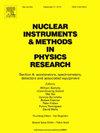Energy calibration and stability of the 3 MV accelerator at CIRCE for applications in Nuclear Astrophysics
IF 1.5
3区 物理与天体物理
Q3 INSTRUMENTS & INSTRUMENTATION
Nuclear Instruments & Methods in Physics Research Section A-accelerators Spectrometers Detectors and Associated Equipment
Pub Date : 2025-03-21
DOI:10.1016/j.nima.2025.170429
引用次数: 0
Abstract
A 3 MV NEC 9SDH-2 Pelletron accelerator is installed at the Center for Isotopic Research on Cultural and Environmental Heritage of Dipartimento di Matematica e Fisica, Università degli Studi della Campania “Luigi Vanvitelli”, Caserta (CIRCE-DMF). The accelerator serves several beam lines devoted to both applied and fundamental research. While generally a precise and accurate knowledge of the energy of the charged particle beams is of interest for all applications, the measurement of charged particle nuclear reactions of astrophysical energies is particularly demanding because of the strong energy dependence of the cross section below the Coulomb barrier and the very long duration of the measurements. We describe here the energy calibration of the accelerator installed at CIRCE-DMF and a measurement of the short term stability. A routine to improve the long term stability and remove the observed dependence of the terminal voltage on the injected current was successfully tested. Finally, possible improvements are discussed.
中国核天体物理研究中心3mv加速器能量标定与稳定性研究
一个3 MV NEC 9SDH-2 Pelletron加速器安装在Caserta (CIRCE-DMF) Luigi Vanvitelli坎帕尼亚大学(universitecomdegli Studi della Campania“Luigi Vanvitelli”)的数学和Fisica Dipartimento文化和环境遗产同位素研究中心。加速器服务于几条致力于应用和基础研究的束流线。虽然一般来说,对带电粒子束的能量的精确和准确的了解是所有应用的兴趣,但由于库仑势垒以下截面的强能量依赖性和测量的持续时间很长,对天体物理能量的带电粒子核反应的测量要求特别高。我们在这里描述了安装在CIRCE-DMF的加速器的能量校准和短期稳定性的测量。成功地测试了一种提高长期稳定性和消除观察到的终端电压对注入电流的依赖的常规方法。最后,讨论了可能的改进。
本文章由计算机程序翻译,如有差异,请以英文原文为准。
求助全文
约1分钟内获得全文
求助全文
来源期刊
CiteScore
3.20
自引率
21.40%
发文量
787
审稿时长
1 months
期刊介绍:
Section A of Nuclear Instruments and Methods in Physics Research publishes papers on design, manufacturing and performance of scientific instruments with an emphasis on large scale facilities. This includes the development of particle accelerators, ion sources, beam transport systems and target arrangements as well as the use of secondary phenomena such as synchrotron radiation and free electron lasers. It also includes all types of instrumentation for the detection and spectrometry of radiations from high energy processes and nuclear decays, as well as instrumentation for experiments at nuclear reactors. Specialized electronics for nuclear and other types of spectrometry as well as computerization of measurements and control systems in this area also find their place in the A section.
Theoretical as well as experimental papers are accepted.

 求助内容:
求助内容: 应助结果提醒方式:
应助结果提醒方式:


